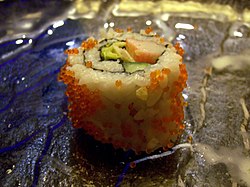California roll

The California roll (カリフォルニアロール, Kariforunia rōru) is a maki-zushi, a kind of sushi roll, usually made inside-out, containing cucumber, crab meat or imitation crab, and avocado. In some countries it is made with mango or banana instead of avocado. Sometimes crab salad is substituted for the crab stick, and often the outer layer of rice (in an inside-out roll) is sprinkled with toasted sesame seeds, tobiko or masago.
As one of the most popular styles of sushi in the US market and abroad, the California roll has been influential in sushi's global popularity and in inspiring sushi chefs around the world in creating their non-traditional fusion cuisine.[1]
History
In the 1960s, Los Angeles, California became the entry point for sushi chefs from Japan seeking to make their fortune in the United States. The Tokyo Kaikan restaurant then featured one of the first sushi bars in Los Angeles. Ichiro Mashita, a sushi chef at the Kaikan, began substituting avocado for toro (fatty tuna), and after further experimentation, the California roll was born.[2] (The date is often given as the early 1970s in other sources.)[3][4][5] Mashita realized the oily texture of avocado was a perfect substitute for toro.[3] Traditionally sushi rolls are wrapped with nori on the outside. But Mashita also eventually made the roll "inside-out", i.e. uramaki, because Americans did not like seeing and chewing the nori on the outside of the roll.[3]
After becoming a favorite in Southern California it eventually became popular all across the United States by the 1980s. The roll contributed to sushi's growing popularity in the United States by easing diners into more exotic sushi options.[6] Sushi chefs have since devised many kinds of rolls, beyond simple variations of the California roll. Many sushi restaurants in North America now feature a menu of such rolls.
In 2005, Japanese comedian named Gori visited to California and made a record of longest California roll which is approximately 100 feet.
In 2009, the local students in California have updated the record from 100 feet to about 300 feet which is still known as the world's longest California roll in the world.
See also
References
- ^ Renton, Alex (2006-02-26). "How Sushi ate the World". The Guardian. Retrieved 2006-08-20.
{{cite news}}: Italic or bold markup not allowed in:|publisher=(help) - ^ "Raw". New York Times. 2007-06-10. Retrieved 2008-08-15.
{{cite news}}: Italic or bold markup not allowed in:|publisher=(help) - ^ a b c Hunt, Maria (2005-08-24). "East-West Fusion: nontraditional ingredients give sushi local flavor". San Diego Union-Tribune. Retrieved 2006-08-20.
{{cite news}}: Italic or bold markup not allowed in:|publisher=(help) - ^ History of the California roll with various early recipes and references
- ^ Some further info on Mashita and the original California roll
- ^ Kestler, John (2006-06-18). "The Sushification of America". The Atlanta Journal-Constitution.
{{cite news}}: Italic or bold markup not allowed in:|publisher=(help)
